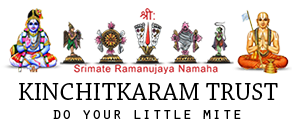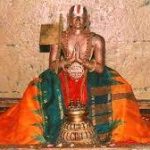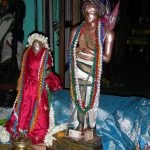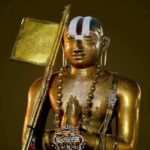Srimathe Ramanujaya Namaha,
Adiyen Acharyan and all PoorvAcharyargal ThiruvAdigalaey Sharanam,
Velukkudi Sri Krishnan Swami ThiruvAdigalil adiyen Shaashtaanga DhandavAt Pranaamam,
Namaskaram to All Adiyaars,
Vikram Swami’s concern and expression is valid, and Ragesh Swami’s suggestion to tackle on such situations are true based on Poorvacharyas Upadesams.
Now with Acharya ThiruvAdi Bhalam & Sarva Guru ThiruvAdi Anugraham and Velukkudi Sri Krishnan Swami’s Aasirvadham, adiyen will share the PRAMAANAM (Actual Reference) for the above conversations and many more additional IN-DEPTH details which is applicable to adiyen or any other devotees, so we have to make our own judgement based on PoorvAcharyas Upadesams and MOVE FORWARD for future Pleasant Life, Kainkaryam and Moksham.
Please refer to Pillai LokAcharya Swami’s “Sri Vachana Bhushanam Grantham” for these details and Velukkudi Swami’s Kalakshapm on this topic.
At this moment, adiyen will copy paste from Online SriVaishnava Blog written by Sarathy rAmAnuja dasan Swami (Shisya of Srimath Paramahamsa ithyAdhi Kaliyan RAmAnuja jeeyar swAmy, 30th pattam, varthamAna swAmy, vAnamAmalai mutt).
**************
ApachArams to avoid
For Srivaishnavas, shAstram is the foundation – we depend on shAstram for every action we do. ShAstram means that which instructs us on “what to do (vidhi) and what not to do (nishEdham)”.
In Srivachana bhushanam divya Grantham, in sUtrams 300 to 307, piLLai lOKAchAryar explains that a srivaishnava must be Ashakthan (incapable to do) in these following 4 matters:
1) akruthya karaNam – not indulging in what is rejected in ShAstram
2) bhagavadh apachAram – apachArams in emperumAn’s (Perumal/SriKrishna) vishayam
3) bhAgavatha apachAram – apachArams in bhAgavatha vishyam
4) asahya apachAram – apachArams in bhagavadh/bhAgavatha vishayam that happens without any reason
Let us see one by one in detail:
1) akruthya karaNam
ShAstram in general asks us to refrain from the following items:
- para himsai – giving trouble to any living being. even hurting a plant or small ant unnecessarily is not accepted in ShAstram.
- para stOtram – our speech ability is provided by emperumAn to praise him and his adiyArs. It should never be used to praise avaishnavas.
- para dhAra parigraham – we should never think about another woman who is not married to us with any wrong intentions.
- para dhravya apahAram – we should never take some one else’s property directly or indirectly unless the owner gives it to us willingly.
- asathya kathanam – speaking what is opposite to reality/truth and what is not helping any living being.
- apakshya pakshaNam – eating food stuffs which has jAthi, Asraya or nimitha dOsham – see AhaAra niyamam for detailed discussion on this topic.
- many other such restrictions given by manu smriti, etc.
It is important for a srivaishnava to first follow the sAmAnya shAstra vidhi and avoid the nishEdha vishayams.
2) bhagavadh apachAram
piLLai lOKAchAryar continues to explain the next nishEdha vishayam – bhagavadh apachAram. He explains this in great detail and mAmunigaL gives wonderful commentary for these. The following are listed as bhagavadh apachAram:
- To consider emperumAn at the same level as dhEvathAntharams – for a srivaishnava it is paramount to understand that emperumAn is sarvEshvaran, one who is the lord of every one (including brahmA, shivan, indran, varuNan, agni, etc) and he is the antharyAmi (one being inside everyone to control their acts). There is no one equal to him or higher to him. With that understanding, we should fully abstain from indulging in any relationship with dhEvathAntharams.
- To consider avathArams such as rAma, krishna, etc as normal or (even super) humans. One should understand that emperumAn appears in this samsAram with all his qualities as in paramapadham. As part of his leelai, he enters in to garbham of a woman, being born on a particular day, goes through difficulties like vana vAsam, etc – but he is not bound by karma at all – instead all of these happen out of his iccha (desire) to help jIvAthmAs who are suffering in samsAram. So, just because of these difficulties he takes up on himself, we should never think that he is also like other humans.
- To disrespect the varnAshrama limits – One should strictly follow varna and Ashrama rules and regulations. Because emperumAn says “sruthi smriti mama Eva AjnjA … AjnA chEthi mama dhrOhi, madh bhaktOpi na vaishnava:” – sruthi and smrithi are his orders and who does not follow them are his drOhis and even if he is a bhaktha he will not be considered a vaishnava. In this particular case, Swami Manavaala mAmunigaL explains, fourth varna srivaishnavas using vaidhIha manthrams during thiruvArAdhanam (Acharya Upadesa Manthrams are allowed), sanyAsis eating beetle nuts are some of the acts which are not allowed by ShAstram.
- To value the archA vigraham (deity) based on the raw materials that are used to make it – We should understand that emperumAn out of the pure love for his bhakthAs, takes up the form which they desire. If we say that because this is a gold vigraham it is great and this is a stone vigraham or just a picture it is not so good. That is explained in ShAstram as questioning the purity of one’s own mother.
- To consider the jIvAthmA as independent – our svAthanthriya budhi is the main cause for all kinds of sins and this is explained as the biggest theft in ShAstram. We should understand that jIvAthmA is only subservient to emperumAn and act according to that.
- To steal bhagvadh dhravam (things that belong to emperumAn). This includes stealing emperumAn’s properties like his bhOgam, thiruvAbharanam, vastram, etc. Also stealing immovable properties like his land, etc., can be included here which are quite common these days.
- To help those who do the above acts of stealing.
- To accept those stolen properties from those who steal or help others to steal emperumAn’s properties. Even accepting with the thought of “well, we did not want those, but they are giving it, so why not accept it” is not favourable to emperumAn.
- many other such behaviors that are condemned in ShAstram.
3) bhAgavatha apachAram
Primarily, it is explained that just considering another srivaishnava EQUAL to us itself is a bhAgavatha apachAram – we should always consider ourselves lower than other srivaishnavas (Neechan or Adiyen Dasanudasan or Adiyen CharamavAthi dasan). One who doesn’t reflect these in their behavior or writings are considered as opposite. In this section, piLLai lOKAchAryar very briefly explains that “bhAgavatha apachAram is that enemity which is developed in us against srivaishnavas, out of desire towards wealth and lust or jealousy of their knowledge etc…”. But detailed explanation of bhAgavatha apachAram is discussed in sUtrams 190 to 207.
Let us see the essence of those sUtrams. First we need to have some context on bhAgavatha apachAram:
- Those who have srivaishnava vEsham (dress, Urdhva pundram, etc) but engage in bhAgavatha apachAram are like clothes which are folded nicely but burnt internally. When a strong wind blows, they will fly into pieces.
- We also have to understand that emperumAn’s avathArams like varaha, naraismha, rAma, krishna, etc and his acts in those avathArams are mainly due to the apachArams done by hiraNya, rAvana, etc to emperumAn’s bhakthas. It is because of his anguish in seeing the suffering of his bhakthAs, he takes up these avathArams in samsAram. We can easily understand this from his own words on his avathAra rahasyam in the fourth chapter of bhagavath gIthai in the slOkams – “yadhA yadhA…”, “parithrAnAya sAdhuanam…”, “bhahUni mE vyathIthAni…”, “ajO api sann…” and “janma karma ca mE divyam…”. In their gitA bhAshyam and thAthparya chandrikai, emperumAnAr and vedhAnthAchAriar has explained these slOkams in great detail.
There are also several types of bhAgavatha apachAram – discriminating/disrespecting a srivaishnava based on his/her birth, knowledge, acts, food, relatives, place of living, etc.
Out of these, discriminating/disrespecting based on a srivaishnava’s birth is the cruelest one. This is considered to be even worse than valuing the archa vigraham of emperumAn based on the raw material it is made of (it is already explained that this is similar to questioning the purity of one’s own mother).
The fact that we disrespect another srivaishnava based on any of the above is in itself sufficient to cause bhAgavatha apachAram. Our pUrvAchAryas have maintained such strict standards while dealing with other srivaishnavas. They were cautious all the time. For example, even an AchArya will treat his sishya with utmost respect – that is the level of dignity they were maintaining. What we see today to some extent is total degradation – even the sishya is not giving respect to his/her own AchArya and saying things like “well, he is not so knowledgable.”, “but he is also after money, how can I respect him”, etc
The results of bhAgavatha apachAram are also explained in detail here.
-
- Thrisangu’s example is explained here – He insisted to his AchArya (vasishta maharishi) and subsequently vasishta’s sons to make him go to svargam with the existing body. Since they refused to do that he got angry and seeing that vasishta’s sons cursed him to become a chandALan. The same yajnOpavItham which establishes his brahma Gyanam, became the belt which chandALas wear. Likewise if srivaishnavas commit apachArams, being in a such high position (being a srivaishnava) any pApams/mistakes that they do will have the most severe punishment according to ShAstram – since they are expected to be very pure. Just like if the Prime Minister of the country is involved in some corruption – every one thinks so low of him, but if a common man is involved in corruption no one will care about that.
- Thondaradi podi AzhwAr said “thamargaLil thalaivarAya chAthi aNthanNargaLElum” (“தமர்களில் தலைவராய் சாதி அந்தணர்களேலும் _”) – even if a person is born in brAhmana family, had brahmOpadhEsam and fully qualified himself in vedhas, if he commits an apachAram to a srivaishnava (who just understands the sambandham between emperumAn and himself but may not have any other Gyanam and anushtAnam), this brAhmana will become like a chandALa immediately. We should not think that even after doing so many apachArams to srivaishnavas we do not see anyone change their forms – the change need not be physical.
- Even when Garudan thought about chAndili (who is emperumAn’s bhakthai) that why she is living in a secluded place instead of divyadhEsam, he immediately lost his wings.
- When piLLai piLLai AzhwAn continuously commits bhAgavatha apachAram, koorathAzhwan corrects him in many ways highliting the importance of avoiding such apachArams. Finally, we should understand a very important point. As we understand/believe that, “we get mOksham purely by our relationship to our AchArya irrespective of our Gyanam and anushtAnam”, the same way “we will fall down to the bottom of samsAram purely by our apachAram to a srivaishnava irrespective of our Gyanam and anushtAnam”.
4) asahya apachAram
asahya means without any reason. These are the apachArams we commit towards emperumAn, AchArya or srivaishnavas without any specific reason.
- In bhagavadh vishyam – hiranyakasipu just did not want to hear about emperumAn – even though emperumAn did not do anything particular to him.
- In AchArya vishayam – not following his instructions, explaining the knowledge he taught to unqualified persons in expectation of wealth, fame, etc
- In bhAgavatha vishayam – having jealosy towards other srivaishnavas, etc.
It is explained that each of these apachArams (in order) are crueler than the one before.
That is, bhagavadh apachAram is crueler than akruthya karanam, bhAgavatha apachAram is crueler than bhagavadh apachAram and asahya apachAram is crueler than bhAgavatha apachAram.
Our pUrvAchAryas were very respectful to ShAstram and were very fearful of commiting any apachAram. Every AchArya in our guruparamparai (as we can see from their history), towards the end of their life in this samsAram, will gather all their sishyAs and other srivaishnavas and ask for their forgiveness even though they did not commit any apachAram at all. Such was their humility.
For us also, it is important to understand this clearly, and try to apply in our lives.
GyAnam exemplifies when it leads to anushtAnam – if that does not happen that GyAnam can simply be the called agyAnam.
We should also understand clearly that this does not mean that srivaishnavas did not share their knowledge in ShAstram to other srivaishnavas fearing that it will cause bhAgavatha apachAram. If that was the case, we would not have so many granthams by our pUrvAchAryas and even contemporary AchAryas in our sampradhAyam explaining how we should live.
The goal of these granthams is to educate us to:
- Develop these good qualities by reading them and
- Apply in our Life with Acharya Ramanujar’s Grace and
- Spent a Fruitful life by doing Kainkaryam and reach Moksham with Acharya Ramanujar’s Grace.
Adiyen Srinivasa (DhoddayaAcharyar) Dasan,
Sarathy rAmAnuja dasan Swami ThiruvAdigalaey Sharanam,
(who wrote the above in SriVaishnava Blog and a Shisya of Srimath Paramahamsa ithyAdhi Kaliyan RAmAnuja jeeyar swAmy, 30th pattam, varthamAna swAmy, vAnamAmalai mutt).
Sri Velukkudi Krishnan Swami ThiruvAdigalaey Sharanam,
Acharyar ThiruvAdigalaey Sharanam,
Pillai LokAcharyarr Swami Thiruvadigaley Sharanam,
Ramanujan Yennai Aandananey,
Sarvam SriKrishnarpanam Asthu



